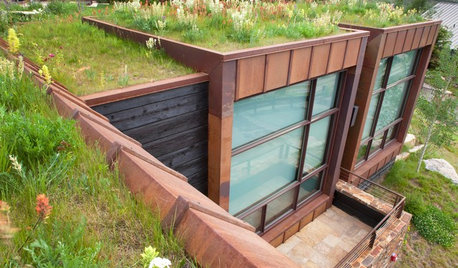Sod - how green is green?
danielj_2009
9 years ago
Related Stories

GARDENING GUIDESHow to Plant a New Lawn From Sod
Take the quick-start route to turf with sod; these installation guidelines will help ensure a healthy and long-lasting lawn
Full Story
GREEN BUILDING6 Green-Roof Myths, Busted
Leaky, costly, a pain to maintain ... nope, nope and nope. Get the truth about living roofs and see examples from simple to elaborate
Full Story
GREENColor Guide: How to Work With Green
With as many green hues as leaves in a forest, it's easy to find one that grows on you
Full Story
GREENKitchen of the Week: Green and Gorgeous in California
An apple-green countertop color matches this kitchen renovation's green approach: ecofriendly floors, sustainably harvested wood and more
Full Story
DECORATING GUIDESSo Your Style Is: Green
Way beyond a hue on a paint chip, green means a healthy home with a unique style designed around sustainability
Full Story
BATHROOM DESIGNGreen and Clean: Ecofriendly Tub and Shower Surrounds
Keep your bathroom beautiful and your footprint green with long-lasting, ecofriendly surface materials
Full Story
COLORDreaming in Color: 8 Gorgeously Green Bedrooms
Bring in a bold splash of watery blue-green or a slice of soft celery for a colorful yet sleep-friendly sanctuary
Full Story
COLORBathed in Color: When to Use Green in the Bath
Splash some spring-conjuring green paint, tiles or accessories around your bathroom for natural appeal
Full StoryMore Discussions










yardtractor1
danielj_2009Original Author
Related Professionals
Baltimore Landscape Architects & Landscape Designers · Brentwood Landscape Architects & Landscape Designers · Cottonwood Landscape Architects & Landscape Designers · Montgomeryville Landscape Architects & Landscape Designers · Owings Mills Landscape Architects & Landscape Designers · Panama City Landscape Architects & Landscape Designers · Stoughton Landscape Contractors · Waterbury Landscape Contractors · Concord Landscape Contractors · Peabody Landscape Contractors · Coram Landscape Contractors · Fishers Landscape Contractors · Siloam Springs Landscape Contractors · Charlottesville Swimming Pool Builders · Midwest City Swimming Pool Buildersmorpheuspa (6B/7A, E. PA)
dchall_san_antonio
yardtractor1
dchall_san_antonio
yardtractor1
morpheuspa (6B/7A, E. PA)
yardtractor1
dchall_san_antonio
morpheuspa (6B/7A, E. PA)
yardtractor1
morpheuspa (6B/7A, E. PA)
yardtractor1
morpheuspa (6B/7A, E. PA)
danielj_2009Original Author
yardtractor1
morpheuspa (6B/7A, E. PA)
danielj_2009Original Author
morpheuspa (6B/7A, E. PA)
dchall_san_antonio
yardtractor1
morpheuspa (6B/7A, E. PA)
dchall_san_antonio
morpheuspa (6B/7A, E. PA)
danielj_2009Original Author
yardtractor1
danielj_2009Original Author
lou_spicewood_tx
morpheuspa (6B/7A, E. PA)
danielj_2009Original Author
morpheuspa (6B/7A, E. PA)
yardtractor1
danielj_2009Original Author
danielj_2009Original Author
yardtractor1
danielj_2009Original Author
morpheuspa (6B/7A, E. PA)
yardtractor1
dchall_san_antonio
morpheuspa (6B/7A, E. PA)
danielj_2009Original Author
dchall_san_antonio
morpheuspa (6B/7A, E. PA)
dchall_san_antonio
danielj_2009Original Author
danielj_2009Original Author
morpheuspa (6B/7A, E. PA)
yardtractor1
morpheuspa (6B/7A, E. PA)